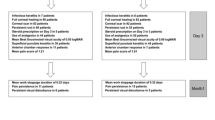Abstract
Objective
To compare the efficacy of two forms of eye care (hypromellose and Lacri-Lube combination vs polyethylene/Cling wrap covers) for intensive care patients.
Design
Randomised-controlled trial.
Setting
University affiliated, tertiary referral hospital.
Patients and participants
One hundred ten patients with a reduced or absent blink reflex were followed through until they regained consciousness, were discharged from the facility during study enrolment, died or developed a positive corneal ulcer or eye infection.
Interventions
All patients received standard eye cleansing every 2 h. In addition to this, group one (n=60) received a treatment combining hypromellose drops and Lacri-Lube (HL) to each eye every 2 h. Group two (n=50) had polyethylene covers only placed over the eye to create a moisture chamber.
Measurements and results
Corneal ulceration was determined using corneal fluorescein stains and mobile slit lamp evaluation, performed daily. No patients had corneal ulceration in the polyethylene cover group, but 4 patients had corneal ulceration in the HL group.
Conclusions
Polyethylene covers are as effective as HL in reducing the incidence of corneal damage in intensive care patients.
Similar content being viewed by others
References
Hernandez EV, Mannis MJ (1997) Superficial keratopathy in intensive care unit patients. Am J Ophthalmol 124:212–216
Imanaka H, Taenaka N, Nakamura J, Aoyama K, Hosotani H (1997) Ocular surface disorders in the critically ill. Anesth Analg 85:343–346
Lenart SB, Garrity JA (2000) Eye care for patients receiving neuromuscular blocking agents or propofol during mechanical ventilation. Am J Crit Care 9:188–191
Mercieca F, Suresh P, Morton A, Tullo A (1999) Ocular surface disease in intensive care unit patients. Eye 13:231–236
Farrell M, Wray F (1993) Eye care for ventilated patients. Intensive Crit Care Nurs 9:137–141
Cortese D, Capp L, McKinley S (1995) Moisture chamber versus lubrication for the prevention of corneal epithelial breakdown. Am J Crit Care 4:425–428
Fleiss J (1981) Statistical methods for rates and proportions. John Wiley, New York
Astori IP, Muller MJ, Pegg SP (1998) Cicatricial, postburn ectropion and exposure keratitis. Burns 24:64–67
Spencer T, Hall AH, Stawell R (2002) Ophthalmologic sequelae of thermal burns over ten years at the Alfred Hospital. Ophthal Plast Reconstr Surg 18:196–201
Boyd-Monk H, Steinmetz III C (1987) Nursing care of the eye. Appleton and Lange, Norwalk, Connecticut
Sullivan J, Brooks-Crawford J, Whitcher J (1999) Lids, lacrimal apparatus and tears. In: Vaughan D, Asbury T, Riordan-Eva P (ed) General ophthalmology. Appleton and Lange, Stamford, Connecticut, pp 74–91
Gilbard J (2000) Dry-eye disorders. In: Albert D, Jakobiec F (ed) Principles and practice of ophthalmology. WB Saunders, Philadelphia, pp 982–1001
Newell F (1996) Ophthalmology: principles and concepts. Mosby, St. Louis
Parkin B, Cook S (2000) A clear view: the way forward for eye care on ICU. Intensive Care Med 26:155–156
Kirwan JF, Potamitis T, el-Kasaby H, Hope-Ross MW, Sutton GA (1997) Microbial keratitis in intensive care. Br Med J 314:433–434
Wincek J, Ruttum MS (1989) Exposure keratitis in comatose children. J Neurosci Nurs 21:241–244
Lloyd F (1990) Making sense of eye care for ventilated or unconscious patients. Nurs Times 86:36–37
Parkin B, Turner A, Moore E, Cook S (1997) Bacterial keratitis in the critically ill. Br J Ophthalmol 81:1060–1063
Batra YK, Bali IM (1977) Corneal abrasions during general anesthesia. Anesth Analg 56:363–365
Siffring PA, Poulton TJ (1987) Prevention of ophthalmic complications during general anesthesia. Anesthesiology 66:569–570
Grover VK, Kumar KV, Sharma S, Sethi N, Grewal SP (1998) Comparison of methods of eye protection under general anaesthesia. Can J Anaesth 45:575–577
Orlin SE, Kurata FK, Krupin T, Schneider M, Glendrange RR (1989) Ocular lubricants and corneal injury during anesthesia. Anesth Analg 69:384–385
White E, Crosse MM (1998) The aetiology and prevention of peri-operative corneal abrasions. Anaesthesia 53:157–161
Ellis P, Fraunfelder F (1999) Ophthalamic therapeutics. In: Vaughan D, Asbury T, Riordan-Eva P (ed) General ophthalmology. Appleton and Lange, Stamford, Conneticut, pp 57–73
Jaanus S (1984) Lubricant preparations. In: Bartlett J, Jaanus S (ed) Clinical ocular pharmacology. Butterworth, London, pp 287–297
Ommeslag D, Colardyn F, De Laey JJ (1987) Eye infections caused by respiratory pathogens in mechanically ventilated patients. Crit Care Med 15:80–81
Suresh P, Mercieca F, Morton A, Tullo AB (2000) Eye care for the critically ill. Intensive Care Med 26:162–166
Cunningham C, Gould D (1998) Eyecare for the sedated patient undergoing mechanical ventilation: the use of evidence-based care. Int J Nurs Stud 35:32–40
Acknowledgements
This study was supported by the Queensland Nursing Council’s Research Grant. The views expressed do not necessarily represent the views of the Council or the members, executive officer or staff of the Council. We thank the Medical and Nursing staff of the Royal Brisbane Hospital, Department of Intensive Care Medicine.
Author information
Authors and Affiliations
Corresponding author
Rights and permissions
About this article
Cite this article
Koroloff, N., Boots, R., Lipman, J. et al. A randomised controlled study of the efficacy of hypromellose and Lacri-Lube combination versus polyethylene/Cling wrap to prevent corneal epithelial breakdown in the semiconscious intensive care patient. Intensive Care Med 30, 1122–1126 (2004). https://doi.org/10.1007/s00134-004-2203-y
Received:
Accepted:
Published:
Issue Date:
DOI: https://doi.org/10.1007/s00134-004-2203-y




